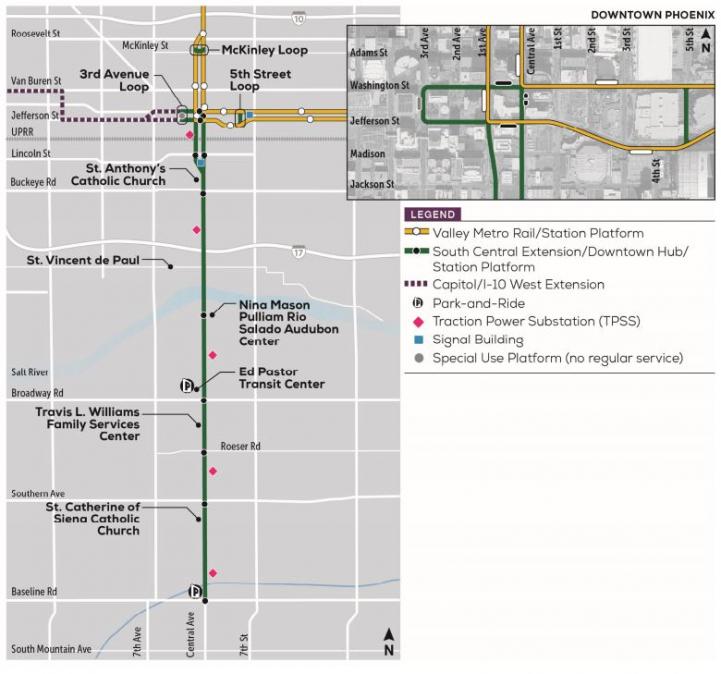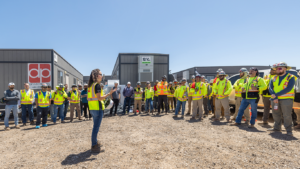A new light rail extension to connect South Phoenix communities to education, work and nightlife downtown is advancing forward with a grant from the U.S. Department of Transportation (DOT).
Slated for completion in 2024, the connection will add 5 miles of light rail to connect residents to the city’s core as well as to the rest of the regional light rail system.
Currently, the Valley’s 28-mile rail line is also spurring economic development and jobs, including $14.4 billion in public and private investment since its inception in 2008, according to Valley Metro Regional Public Transportation Authority, more popularly known as Valley Metro.
READ ALSO: How Downtown Phoenix is emerging as a higher education hub
Lawmakers across the Valley have worked to make the rail and the new South Phoenix extension a reality, U.S. Representative Greg Stanton (D), who is the former mayor of Phoenix.
“This critical federal investment will secure light rail’s future in South Phoenix,” said Stanton, who is a member of the House Committee on Transportation and Infrastructure. “Years of work and advocacy have made this massive infrastructure project possible. And when it’s complete, light rail will be a new connection to South Phoenix that opens new economic opportunities.”
Newest extension part of goal to extend 66 miles
Called the South Central Extension/Downtown Hub, it will run from downtown Phoenix to south of Baseline Road. The project also includes a hub in downtown Phoenix, new stations and public art.
The extension, which will run from Baseline Road in South Phoenix to the downtown transit hub, is one of seven high-capacity extensions planned or under construction to create a 66-mile system by 2034.

The DOT recently announced it was awarding the city a grant of nearly $530 million through DOT’s Capital Investment Grants (CIG) program to help pay for the South Central extension.
The balance of funds needed to fully complete the light rail extension — about $815 million — will come from several federal and local sources: the Federal Highway Administration, Surface Transportation Block Grants, Phoenix Proposition 104 sales tax revenues, and Maricopa County Proposition 400 Public Transportation Excise Tax revenues.
Project spurring economic investment in region
The cities of Phoenix, Tempe and Mesa have taken action to encourage development near the light rail alignment. As a result, more than 414 projects have cropped up or are under construction adjacent to the rail.
More than $14.4 billion in private and public capital investment has been built near the 28-miles of light rail and Tempe Streetcar. Another $3 billion in commercial and residential building is being planned, most of that from private developers.
Fares are $2 per trip
Fares are only $2 for one trip or $4 for one day. Reduced fares of $1 for one trip and $2 for one day are available for riders 6-18 years old, 65 and older, and people on Medicare or with disabilities. Children 5 and under ride for free.
About Valley Metro’s light rail project
Valley Metro’s 28-mile light rail line was built entirely in-street using a train-only trackway and traffic signals to allow trains to safely move through the cities of Phoenix, Tempe and Mesa, Arizona. Along the route, there are 38 stations and 11 free park-and-rides.
The cost was $1.4 billion and was paid for using a $587 million federal New Starts grant, $59 million from federal Congestion Mitigation and Air Quality
funding and local tax dollars. The local funds are a mix of sales tax revenue from the cities of Phoenix and Tempe, the general fund from Mesa and the county’s Proposition 400 half-cent sales tax.
In fiscal 2018, Valley Metro Rail served 15.7 million passengers. Today, more than 45,000 riders rely on light rail each day. Light rail has proven to generate economic prosperity for historically underserved communities in metro Phoenix.
To learn more about the light rail system, visit: Valley Metro Rail.
This story was originally published at Chamber Business News.



